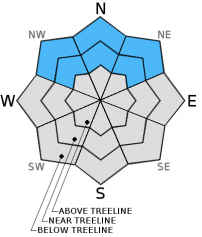| Tuesday | Tuesday Night | Wednesday | |
|---|---|---|---|
| Weather: | Partly cloudy | Partly cloudy becoming mostly cloudy overnight | Mostly cloudy |
| Temperatures: | 38 to 45 deg. F. | 24 to 30 deg. F. | 36 to 43 deg. F. |
| Mid Slope Winds: | Southwest | Southwest | Southwest |
| Wind Speed: | 15 to 20 mph with gusts to 30 mph | 15 to 20 mph with gusts to 30 mph | 10 to 15 mph with gusts to 25 mph |
| Expected snowfall: | 0 | 0 | 0 |
| Tuesday | Tuesday Night | Wednesday | |
|---|---|---|---|
| Weather: | Partly cloudy | Partly cloudy becoming mostly cloudy overnight | Mostly cloudy |
| Temperatures: | 38 to 44 deg. F. | 21 to 28 deg. F. | 33 to 40 deg. F. |
| Ridge Top Winds: | Southwest | Southwest | Southwest |
| Wind Speed: | 20 to 30 mph with gusts to 45 mph | 20 to 30 mph with gusts to 45 mph | 15 to 25 mph with gusts to 40 mph |
| Expected snowfall: | 0 | 0 | 0 |
























